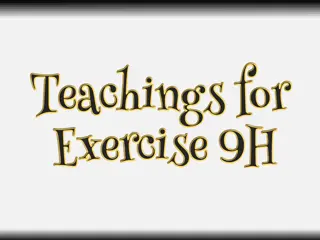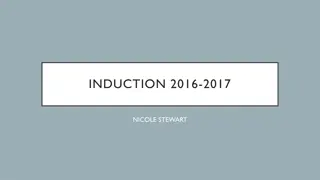Enhancing Classroom Differentiation Strategies for Student Engagement
Effective differentiation in the classroom is crucial to cater to diverse student needs and enhance engagement. Implementing strategies like top and tail activities, careful target setting, individualized next steps, and more can help teachers create a more inclusive and engaging learning environment for all students.
Download Presentation

Please find below an Image/Link to download the presentation.
The content on the website is provided AS IS for your information and personal use only. It may not be sold, licensed, or shared on other websites without obtaining consent from the author.If you encounter any issues during the download, it is possible that the publisher has removed the file from their server.
You are allowed to download the files provided on this website for personal or commercial use, subject to the condition that they are used lawfully. All files are the property of their respective owners.
The content on the website is provided AS IS for your information and personal use only. It may not be sold, licensed, or shared on other websites without obtaining consent from the author.
E N D
Presentation Transcript
The 6 Ts of Differentiation Ian Yule (with lots of help from Sue Cowley The 7 Ts of Differentiation
Why this Learning and Teaching focus: Because surveys suggest that students sometimes find the work too easy or too challenging. Recent educational visit saw few examples of well differentiated lessons. We ve made real progress but we need to improve further in the areas of differentiation and choice. We have an increasing number of pupils where hitting every lesson in the middle is not an appropriate approach. There s an inspection coming.
All good teachers differentiate Careful choice of which pupil to answer which question Your seating plans choosing who works best with whom Changing the level of questioning and level of vocabulary for different students Taking into account pupils are individuals and learn in different ways Planning a range of tasks across a lesson or a unit Careful target setting and individualised planned next steps
1. Top and Tail (Top) Rather than getting quick finishers to check their work or to colour in a picture have a planned extension task which is more challenging: Extend the quantity of the task eg finish all 8 questions when the class does 5. Do a pared down activity: eg explain the task or rewrite their essay in exactly 50 words. Write /create a menemonic to help remember the key learning / vocabulary in the lesson Identify a number of real life situations in which this work could be applied Competition: a word search / word bank / extension quiz (make one or answer a prepared one) Help / teach / mark / read the work of someone else in the class
1. Top and Tail (Tail) Put into worksheets a glossary with definitions of key terms, commands, difficult vocabulary (why not have a laminated glossary of high frequency key terms which can regularly be referred to)? EAL students will definitely require this. Give students a mini whiteboard so they can rewrite your lesson instructions rather than having to remember everything you said. At the start of lessons check in with weakest students FIRST so that they can begin quickly (use ANA if available) Partner weakest students with more able for PARTS of lessons READ OUT LOUD long sections of text don t leave weaker students to read it for themselves in silence Use CLOZE activities as an alternative for weaker students (these need to be prepared in advance but are there for as long as you teach the activity. LS could help here).
Top and Tail your TALK Ask the same question in a range of ways (very simple / straightforward / more complex): What are the five most interesting words in this paragraph? I m looking for 5 adjectives in this paragraph. Who can find them? What do you think are the 5 best examples of the writer s use of word choice in this paragraph? Make notes / highlight / annotate Show / demonstrate / exemplify Idea / thought / notion / concept Tell / describe / detail / specify
Targets (for your planning) In lessons have one objective / target for everyone then have extension objective ready for the more able / faster workers Target every child in the class make sure you speak to everyone Target one lesson a week or parts of a unit of lessons where you WILL differentiate OR Target one group of students (able / weaker) where you will differentiate for their needs in a unit of lessons (over time ALL of your units will be differentiated)
Targets (for your students) For weaker / behaviourally challenged students identify one core piece of the learning (differentiated as a cloze / puzzle / diagram to label) where you expect them to focus and achieve. Praise and reward on success. Create an ethos of praise. EG Star of the week which can cover attainment / homework / politeness / hard work / helping someone else and reward success. Make it clear how this target can be achieved. Set a range of tasks assessing different things in each one this will create a greater opportunity for success. Don t just include academic success include neatness, presentation, width of content, literacy, numeracy etc Make it clear what you are assessessing. Use the Report to make it clear where students are in their subject. Don t use colours inappropriately. However use the next steps box to make an individualised comment for each student: set a realistic area for improvement even if it is to make their work neater or to do more in the time given. If you are differentiating it will be clearer to you what they need to do to step forward.
Thinking Skills Use the plenary to get students (in pairs) to list the 3 most important things they have learned then rank them in order. Discuss then use planners to evaluate depth. Get students to write top tips for learning (eg The 3 most important words / facts you need to learn are ) for the next group of students who will learn this (really useful for subjects who have rotations). Make sure you use it when this gets around it will be powerful. Plan to have a week where students can choose what they learn. Start with a limited range with teacher in great control. Eg outcome can be a graph / poster / work of art / powerpoint / photograph montage Plan a range of tasks using colour: red for hard / amber for medium / green for easy. Allow students freedom to make their choice. More able students could choose two. Turn your room into work stations where you set the tasks. Challenge students to work in 2/3 work stations across the week not necessarily completing the whole task. Use the Three before me approach: try again, ask a friend, consult a reference (put on the wall helpful resources) or check online if all that fails then they can ask you for help. This will free you up to teach groups / individuals.
Teamwork (different kinds of groups) Time Teams: groups are differentiated by the amount of time they have to do each task / the quantity of tasks Text Teams: groups are differentiated by the level of literacy of the text / questions Think Teams: The level of difficulty of the concept / thinking around the task /complexity of response is differentiated for the group Task Teams: each member of the group is get a role, differentiation is accomplished through the complexity of the role: chair / business manager / producer / resource manager / negotiation with other groups and teacher / summariser / time keeper Talent Teams: groups are mixed according to something they do well, eg a group who write up the outcomes, a group who make good powerpoints, photographs etc
Technology Get students to use a digital camera to photograph / video the key parts of the activity (excellent extension task for able students and quick finishers) Technologically able students could create department blog / web / Facebook page Film your instructions so that weakest students can review them several times / film your lesson for discussion and deeper learning at a later stage (Flip the classroom) Get students to use / set timers on smart phones for certain tasks Allow students to check online or use a search engine on their smart phones as part of the thinking process before they consult with you.
Time Clearly set amounts of time for tasks: consider what time is needed to PUSH the thinking of the most able and MOTIVATE the less able. Ask your students how much time they think they need for a task. After a discussion tell them they will now do it in half the time. Hand out the worksheet the lesson beforehand. Able students can complete in time then do extension work in class. This leaves you time to work with less able. Give ANAs amounts of time to work with each child / group Use a timer / countdown clock for tasks students need to see time disappearing Give groups a small sand timer Open ended project work (perhaps linked to homework) allows the most able to shine
The 7thT ? Things think about how you use the resources in your room Dictionaries / Thesaurus / Glossaries / Smart phones People (including ANAs, able students helping weaker / senior pupils who have done the work before) Objects (eg a cardboard box to open up the imagination: where could it go / what could they turn it into / how was it made? Youtube clips to illustrate / fire the imagination Writing frames: have a planned support frame for answers to questions as well as a paragraph plan with key words / vocabulary ready
When to approach Additional Support All of the contents of this presentation should be achieved by the autonomous professional in the classroom. This is what we are expected to do as teachers. Faculties can work together to produce work at different levels / differentiated tasks / improve choice etc PT Additional Support happy to attend Faculty DMs and discuss smart tasks for Additional Support to help teachers and learners Ian, Moira and Viv all happy to discuss individual students and share our ideas for approaches there are students for whom a VERY individualised approach will be needed All ANAs report that there are times the tasks are not only beyond the students they don t understand them either! Don t forget to talk to ANA in advance even at the start of the lesson whenever you can.
Follow through This presentation will be available in shared area Teacher s preparation planner can be used to check your differentiation ideas / plans / provide evidence / be the basis for a useful Faculty discussion (Ian happy to facilitate and support this) Sue Cowley The 7 Ts of Differentation Mike Gershon How to use differentiation in the classroom























